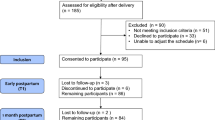Abstract
Study design:
A case report.
Objectives:
To present a case of postpartum hypogalactia in a woman with Brown–Séquard-plus syndrome (BSPS).
Setting:
Outpatient spinal cord injury (SCI) clinic.
Case report:
A 33-year-old woman with C4 AIS D tetraplegia (American Spinal Injury Association Impairment Scale) was followed at the outpatient SCI clinic for the past 5 years. Her right side presents with increased tone, increased spasticity and decreased sensitivity to light touch. Conversely, her left side presents with minimal changes in tone and no motor function deficits, but decreased sensitivity to pinprick and temperature sensation. These findings are consistent with BSPS. After inpatient rehabilitation, she was engaged, married, and 8 months ago delivered a healthy child. After an uncomplicated delivery, breastfeeding was attempted, but a significant lack of lactation was noted the first month postpartum from the right breast. Despite the implementation of measures to increase lactation, the lack of lactation from the right breast persisted, and required initiation of formula feeding. The right breast in this case lost not only sensory proprioception, but also autonomic control, which could contribute to this instance of asymmetric lactation.
Conclusion:
In addition to motor and sensory dysfunctions following SCI, autonomic dysfunctions are commonly seen in individuals with these devastating injuries. The lactation on the right side, which had interrupted descending spinal autonomic pathways, was decreased by approximately 83%. This case provides us with interesting information regarding attention that clinicians should be paying when discussing the breastfeeding options for women with SCI.
Similar content being viewed by others
Log in or create a free account to read this content
Gain free access to this article, as well as selected content from this journal and more on nature.com
or
References
Pouw MH, van de Meent H, van Middendorp JJ, Hirschfeld S, Thietje R, van Kampen A et al. Relevance of the diagnosis traumatic cervical Brown-Séquard-plus syndrome: an analysis based on the neurological and functional recovery in a prospective cohort of 148 patients. Spinal Cord 2010; 48: 614–618.
García-Manzanares MD, Belda-Sanchis JI, Giner-Pascual M, Miguel-Leon I, Delgado-Calvo M, Alióy Sanz JL . Brown-Sequard syndrome associated with Horner’s syndrome after a penetrating trauma at the cervicomedullary junction. Spinal Cord 2000; 38: 705–707.
Daly SE, Owens RA, Hartmann PE . The short-term synthesis and infant-regulated removal of milk in lactating women. Exp Physiol 1993; 78: 209–220.
Cox DB, Owens RA, Hartmann PE . Blood and milk prolactin and the rate of milk synthesis in women. Exp Physiol 1996; 81: 1007–1020.
Halbert L . Breastfeeding in women with a compromised nervous system. J Hum Lact 1998; 14: 327–331.
Macciocchi S, Seel RT, Thompson N, Byams R, Bowman B . Spinal cord injury andco-occurring traumatic brain injury: assessment and incidence. Arch Phys Med Rehabil 2008; 89: 1350–1357.
Bondanelli M, De Marinis L, Ambrosio MR, Monesi M, Valle D, Zatelli MC et al. Occurrence of pituitary dysfunction following traumatic brain injury. J Neurotrauma 2004; 21: 685–696.
Alexander MS, Biering-Sorensen F, Bodner D, Brackett NL, Cardenas D, Charlifue S et al. International standards to document remaining autonomic function after spinal cord injury. Spinal Cord 2009; 47: 36–43.
Author information
Authors and Affiliations
Corresponding author
Ethics declarations
Competing interests
The authors declare no conflict of interest.
Rights and permissions
About this article
Cite this article
Liu, N., Krassioukov, A. Postpartum hypogalactia in a woman with Brown–Séquard-plus syndrome: a case report. Spinal Cord 51, 794–796 (2013). https://doi.org/10.1038/sc.2013.51
Received:
Revised:
Accepted:
Published:
Issue date:
DOI: https://doi.org/10.1038/sc.2013.51
Keywords
This article is cited by
-
The availability and quality of breastfeeding guidelines for women with spinal cord injury: a narrative review
Spinal Cord (2022)
-
Parents with a spinal cord injury
Spinal Cord (2016)
-
Breastfeeding by women with tetraplegia: some evidence for optimism
Spinal Cord (2014)
-
Response to ‘Breastfeeding by women with tetraplegia: some evidence for optimism’
Spinal Cord (2014)


